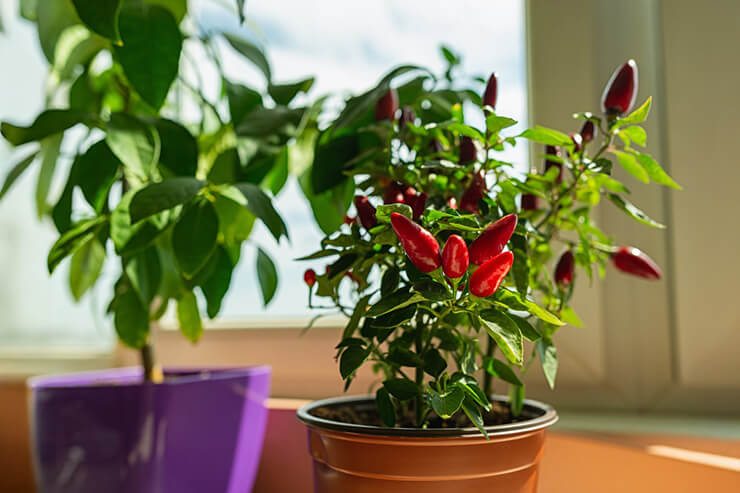Peppers (Capsicum species) are one of the most exciting plants to grow indoors. With vibrant colors, diverse flavors, and striking foliage, peppers add visual flair and culinary spice to any indoor garden. Whether you’re into sweet, crisp bell peppers or fiery little chilis, there’s a variety that fits both your space and your taste.
Unlike their outdoor counterparts, indoor peppers require a bit of extra planning—mainly around light and temperature—but they adapt well to container life. Many smaller or dwarf varieties are bred to thrive in pots, and they’ll happily produce colorful fruits with a little warmth and attention.
Peppers not only taste great, but their growing cycle is highly rewarding to watch—from glossy green leaves and white flowers to ripening pods that can turn red, yellow, purple, or orange right before your eyes. Whether you’re growing for the heat, the sweetness, or the aesthetics, peppers are a dynamic addition to your year-round edible garden.

Soil and pH Preferences
Peppers appreciate rich, well-draining soil that holds moisture without becoming soggy.
- Ideal pH:Aim for a soil pH between 0 and 6.8.
- Soil Type:Use a loose, high-quality potting mix with added compost or worm castings. A blend that includes peat moss, perlite, and organic matter is perfect.
- Nutrition:Peppers are medium to heavy feeders. Incorporate a balanced fertilizer when planting and feed every 2-3 weeks once flowering begins.
Light Requirements
Light is one of the most important factors for success with indoor peppers. They love bright conditions.
- Light Needs:Provide 12-16 hours of light per day.
- Natural Light:A bright south-facing window may be sufficient for some varieties, but most benefit from supplemental grow lights.
- Grow Lights:Use full-spectrum LEDs positioned about 6-12 inches above the plants, adjusting as they grow.
Watering Requirements
Peppers like consistent moisture but dislike wet feet.
- Watering Frequency:Water when the top 1-2 inches of soil feel dry. In warm rooms, this might be every 3-5 days.
- Watering Tips:Water deeply to encourage strong root growth, but let the soil dry slightly between waterings.
- Humidity:Peppers enjoy average humidity (40-60%). Dry indoor air can be balanced with a humidifier or by grouping plants together.
Ideal Indoor Environment
Creating a cozy microclimate helps peppers thrive indoors.
- Temperature Range:Peppers prefer 70-85°F (21-29°C) during the day and no lower than 60°F at night.
- Airflow:Good circulation prevents mold and encourages strong stems. Use a small oscillating fan if the room is still.
- Pollination:Indoor peppers are self-pollinating, but you can give nature a hand by gently shaking the plant or using a soft brush to move pollen between flowers.
- Container Size:Choose pots that are at least 10-12 inches deep and wide. Smaller varieties can do well in slightly smaller containers.
5 Great Pepper Varieties for Indoor Growing
Peppers are among the most diverse edible plants out there. From mild and crunchy to hot and fiery, they bring excitement to the plate and the garden. Indoors, they’re a practical choice—many compact or ornamental varieties stay under 2 feet tall, yet still deliver impressive yields. Their versatility in cooking, pickling, drying, and fresh eating makes them a must-grow crop for indoor gardeners with a flair for flavor.
Mini Bell
These bite-sized bell peppers grow on compact plants and come in red, yellow, or orange varieties. They’re crunchy, sweet, and perfect for snacking.
Indoor Benefits:
- Short plants (12-18 inches tall)
- Early and prolific fruiting
- Great for containers or windowsills
Culinary Uses:
- Stuffed with cheese or hummus
- Sliced into fresh salads or wraps
- Roasted whole for a sweet side dish
Thai Chili
Small but mighty, Thai chilis pack serious heat and grow on bushy, ornamental plants. They’re known for their upright clusters of fiery red fruit.
Indoor Benefits:
- Highly ornamental—fruit stands upright like candles
- Productive in tight spaces
- Heat-tolerant and low maintenance
Culinary Uses:
- Crushed into spicy stir-fries
- Infused into oils or vinegar
- Dried and ground into chili powder
Numex Twilight
This show-stopping pepper produces tiny, upright fruit in a rainbow of colors—purple, yellow, orange, and red—all on one plant.
Indoor Benefits:
- Compact and colorful—great for windows or decorative pots
- Heat level is moderate (about 30,000-50,000 Scoville units)
- Continues to fruit indoors with enough light
Culinary Uses:
- Adds a visual pop to salsa
- Used sparingly in sauces or spicy dishes
- Excellent for drying and display
Jalapeño M
A classic jalapeño, this variety is compact enough for container growing and delivers that signature smoky flavor without overwhelming heat.
Indoor Benefits:
- Good fruit size on manageable plants (up to 24 inches tall)
- Grows well in containers with support
- Early fruiting with consistent yields
Culinary Uses:
- Sliced onto nachos or burgers
- Stuffed and baked with cheese
- Pickled for sandwiches or tacos
Purple Beauty
A deep violet bell pepper with crisp flesh and a sweet, mild flavor. This variety adds drama to your indoor garden and your dinner plate.
Indoor Benefits:
- Grows 18-24 inches tall—great for pots
- Color shifts from green to dark purple
- Slower to mature but worth the wait
Culinary Uses:
- Sautéed or roasted in mixed vegetable dishes
- Eaten raw with your favorite dip
- Diced into vibrant relishes or salsas


 Previous
Previous

